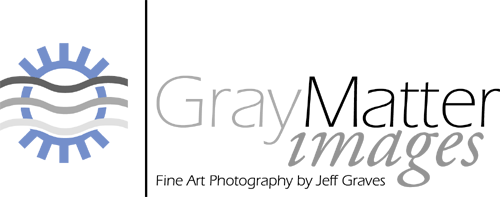My images are captured mostly by film cameras using black and white (silver) film. I use several printing methods consisting of silver gelatin, platinum palladium, cyanotype, polymer gravure as well as the in camera plate making process of “wet plate collodion”.
Silver Gelatin 1890-1960
This is the most modern of the three processes I use. Light sensitive silver salt particles are suspended in a gelatin coating (by machine) on the paper. The film negative is either placed directly on the paper or in a projection enlarger above the paper. The paper is then exposed to light thru the negative for a very short time. The exposed paper is then developed chemically with a metol, sodium sulfite/carbonate and potassium bromide solution that turns the silver salts into silver metal. The development action is stopped by an acid then cleared (fixed) in a sodium thiosulfate solution to wash off any unexposed pieces of silver creating the black to white tonal scale on the white paper base. The image is washed with water then toned in selenium for permanence.
Platinum / Palladium 1873-1890
Noble metals sodium chloroplatinate and sodium palladium are mixed with ferrous oxalate to form the light sensitive solution that is hand coated on a slightly acidic paper. Unlike a “Silver Gelatin” the Platinum/Palladium solution is not suspended by a gelatin layer and soaks directly into the paper taking on the matte texture of the paper. Once the solution is dry the film negative (which size determines the final print) is placed directly on the paper with pressure then exposed to UV light usually about 4-6 minutes. Once the ferric oxalate is exposed to UV light it becomes ferrous. The image is then developed in potassium oxalate turning the ferrous coating into the platinum/palladium metals. The image is cleared by slightly acidic solutions and washed in water. The end result is a rich warm soft image that is the most stable and permanent of all of the photographic processes. This process was short lived due to the high cost of platinum and the complexities of paper coating. Today platinum is trading as high or higher than gold.
Glass Ambrotype 1850-1860
The Ambrotype is an image created on a plate of glass using the “Wet Plate Collodion” process and is also the very basic form of creating black and white photographic film. A black glass plate is coated with “collodion” (a nitro-cellulose film substrate for the silver to adhere) which is a mixture of nitrated gun cotton, alcohol, ether, cadmium bromide and ammonium iodide. The plate is then placed into a bath of silver nitrate for a short time which makes it light sensitive. While the plate is still wet with which is now a silver halide coating and in a “safe light environment” it is placed inside the camera, exposed, removed then immediately developed with a ferrous sulfate solution. The term “wet plate” refers to the fact that it needs to remain wet to be sensitive to light. All of this needs to happen within a 15 minute time period. The development process is stopped by water then the excess silver that was not struck by light is dissolved by a sodium thiosulfate fixer bath. The plate is then washed in water, dried then coated with a gum sandarac and lavender oil varnish. This beautiful process was very short lived due its extremely dangerous nature as well as the need of a traveling darkroom.
Cyanotype 1842-Current
The Cyanotype also known as the modern day “blueprint” was discovered in 1842 by Sir John Herschal. It is a iron based process in which ferric ammonium citrate and potassium ferricynide in water are combined and when dried become sensitive to ultra-violet light. This discovery was instrumental to photography and printmaking and paved the way to our modern photographic systems. Early practitioners include the first woman photographer Anna Atkins and William Henry Fox Talbot.
Photogravure (Polymergravure) 1835-Current
The traditional photogravure print is a result of a photo-mechanical Intalio process in which a metallic plate is coated with a light-sensitive material that has been exposed to a film positive then etched with acid to create a depression in the plate for printing ink to reside in. Once the plate is “inked” it is placed onto printing paper with pressure. I use a less toxic modern day etching plate called a “Solarplate” invented by Dan Weldon. It has a light-sensitive polymer coating on a metallic base. Once it is exposed to ultra-violet light the polymer hardens and becomes the etching surface.
Images can be purchased direct from me (303 912-4668, jeffg@graymatterimages.com) or from one of my represenatives.
